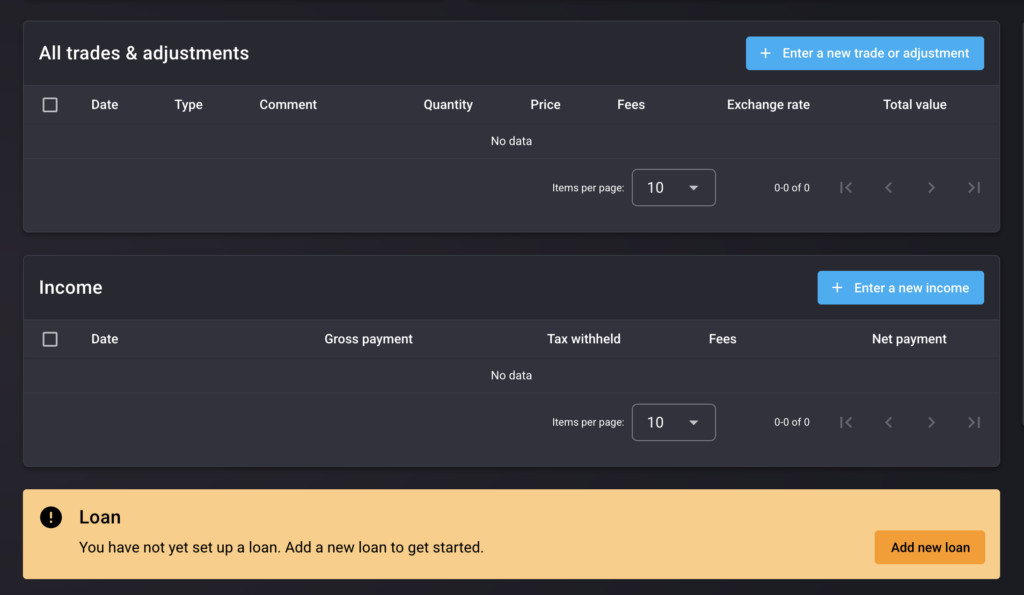Manually Adding a Transaction to the Portfolio
Since real estate is not a publicly traded instrument, it must be entered manually.
- Go to the desired portfolio view and click “Add New”.
- In the opened menu, select “Transaction / Investment”.
- Click on the link “Enter manually”.
- Fill in the investment-related fields. For example:
- Instrument type – Real Estate
- Investment code – For real estate, use something like “Rental Property,” “Commercial Real Estate,” or “Home.”
- Investment name – Property address, e.g., Tammsaare tee 1.
- Currency – EUR
- Click “Add to Portfolio”
Adding Values to the Instrument
Once the real estate property has been added to the portfolio, you will be redirected to the investment page. Here, you can enter the initial balance, cash flows, and loan information if you have used leverage.

Entering an Initial Balance or Purchase Transaction
You have two options:
If you want to start tracking the portfolio from a later date (e.g., the beginning of the year or quarter), select “Initial Balance” instead.
If you want to record the purchase date, the first transaction should be “Buy”.
- Steps to Enter a Purchase or Initial Balance:
- In the Transactions module, click “Add New Transaction”.
- On the opened page, fill in the following fields:
- Select Date – either the purchase date or the initial balance date.
- Choose Transaction Type – either Buy or Initial Balance.
- Account – If you want to track this transaction in a bank account, select the account. If not, leave this field empty.
- Price.
- Transaction Fee.
- Description/Comment.
- Click “Save”.
Entering a Mortgage Loan
Real estate investments often involve mortgage loans.
Portfellow allows you to track loan transactions separately.
- Steps to Enter a Mortgage Loan:
- In the Leverage Loan module, click “Add New Loan”.
- Then, click “Add New Transaction”.
- On the opened page, fill in the following fields:
- Select Date.
- Choose Transaction Type.
- Initial Balance – loan balance at a specific date.
- Loan Disbursement – the amount issued as a loan.
- Principal Repayment.
- Interest Payment.
- Other Fees.
- Account – If you want to track this transaction in a bank account, select the account. If not, leave this field empty.
- Amount.
- Description / Comment.
- Click “Save”.
Note! After adding a mortgage loan, Portfellow creates a new instrument in the portfolio, classified as a loan account.
This is similar to a cash account but is used only for tracking loan-related transactions.
Entering Cash Flow
If the property is a rental investment, it likely generates income.
Rental income can be recorded in the Cash Flow module.
- Steps to Enter Rental Income:
- In the Cash Flow module, click “Add New Income”.
- On the opened page, fill in the following fields:
- Select Date.
- Choose Transaction Type.
- Account – If you want to track this transaction in a bank account, select the account. If not, leave this field empty.
- Gross Payout.
- Withheld Taxes.
- Net Payout – automatically calculated.
- Additional Fees – optionally, add any related transaction fees.
- Click “Save”.
Additional Options
Beyond the basic setup, there are several additional features available.
Managing Prices
Since real estate is not a publicly traded instrument, prices do not update automatically.
You can manually enter price changes for specific dates.
Portfellow saves price history for future reference.
Settings
In this section, you can adjust investment-related details, such as:
- Grouping Key – If you want to combine multiple investments under the same company in the portfolio view.
- Asset Class.
- Custom Groups – Portfellow allows you to categorize investments based on your preferences.
Notes
A section to add custom notes related to the instrument.